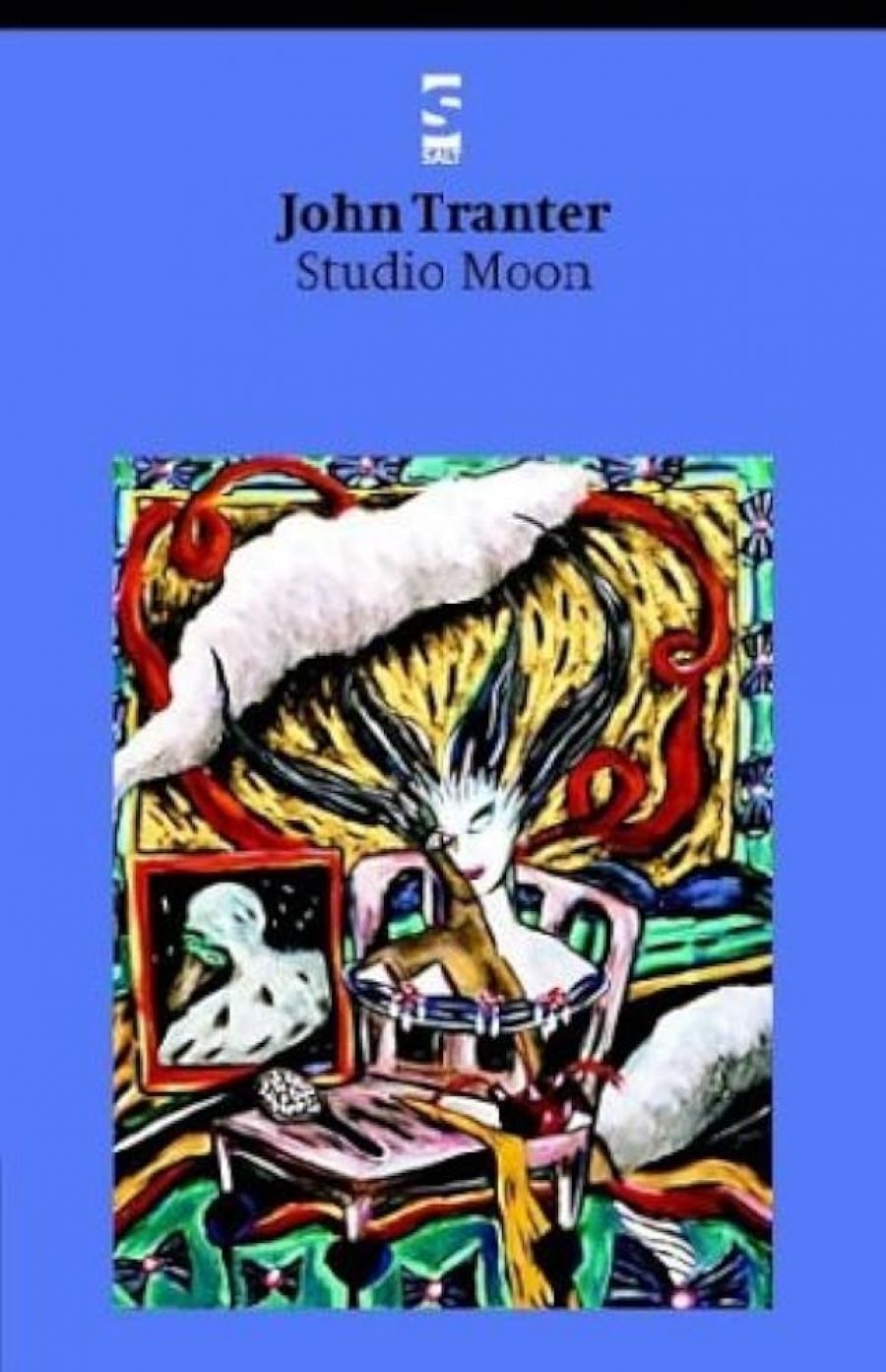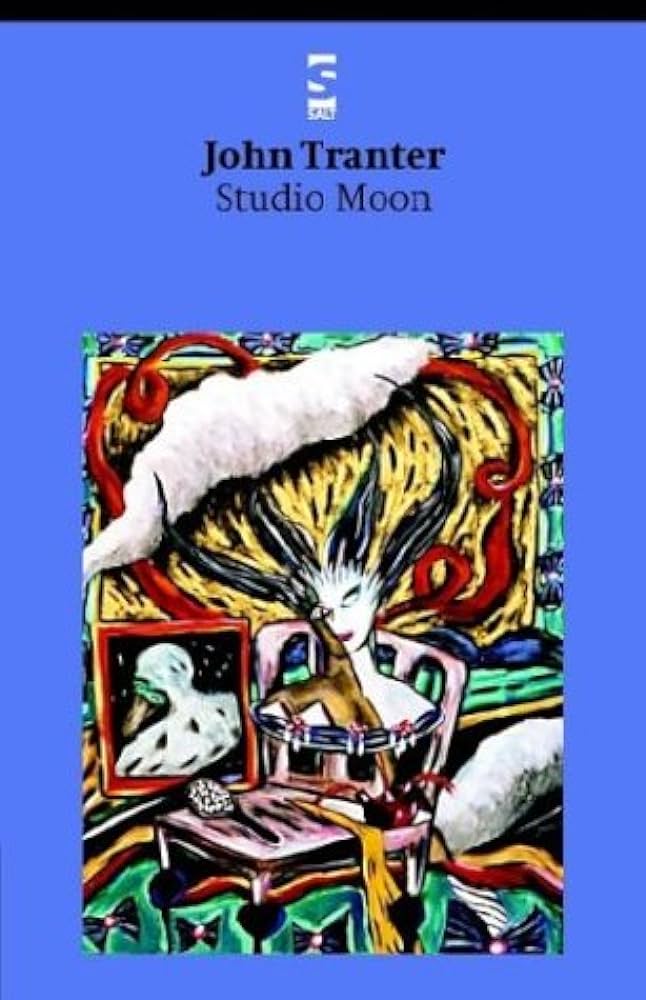
- Free Article: No
- Contents Category: Poetry
- Custom Article Title: Light and Shadow
- Review Article: Yes
- Article Title: Light and Shadow
- Online Only: No
- Custom Highlight Text:
As one of the few Australian poets with an extensive publishing history overseas as well as in Australia, John Tranter suffers from the problem of what might be called parallel publishing. His UK books are often built out of selections from his Australian books. Just under half the poems in his new book, Studio Moon (published by Salt, and distributed in Australia by the Fremantle Arts Centre Press), have appeared before, notably in At the Florida (1993). But the best from that book has been chosen, the new poems are exciting, and the result is a book that manages to be simultaneously powerful, entertaining and revealing.
- Book 1 Title: Studio Moon
- Book 1 Biblio: Salt, $22.95 pb, 114 pp
- Book 1 Cover Small (400 x 600):

- Book 1 Cover (800 x 1200):

Studio Moon demonstrates how varied a poem’s generative concept can be. There are poems such as ‘Address to the Reader’ written in response to other poems; there are loose versions of other poems; and there are a number of poems written by retaining the final words of the lines of an original and changing almost everything else. There are also experiments with various existing forms, especially the haibun, the sapphic stanza and the pantoum.
Many admirers have been puzzled by the generative obsessions of Tranter’s recent verse, but fifteen years is too long a stretch for these interests to be seen as mere passing obsessions. We need to try to make some sort of sense of what is being attempted, and this collection assembles a varied selection of examples. Tranter’s poetry, despite its reputation for abstraction, has always turned to people’s lives for its raw material, no matter how freely they are eventually treated. At the same time, it has always had light and dark sides. The celebratory side has usually revolved around popular culture, and this is beautifully expressed in the first poem of this book, ‘After Hölderlin’, a poem that stands as a kind of epigraph to the collection. The speaker celebrates the books and films that rescued him from ‘the factory floor / or the office routine’: ‘These dreams were my teachers / and I learned the language of love / among the light and shadow / in the arms of the gods.’ Of course, this is not a simple celebration, and one can feel the tension between the sources of Hölderlin’s comfort – the gods – and Tranter’s.
The darker side seems to derive from a view of the universe as entropic. Things are generally bad and show their true beauty in the way they become worse. This is brilliantly expressed in ‘The Romans’, a poem conceived in a dentist’s chair, and one that adopts a suitable stoicism:
Down in the windy park the leaves all turn
over at the same time – it’s the climate
explaining the weather to the workers.It’s like this:
apart from the isotherms repeating themselves
like a patient discussing with her dentist
composite amalgams and the price of gold,
there’s also change –mainly decay, the trees explain, waving to
the mail-boys and the minor librarians and
the ibises busy scavenging among
the lunch wrappers –it’s a helix, looping down into the dark.
I agree, snores the dozing drunk drawing
to the close of his liver’s long career.
From ancient timesto the technical present most things decline;
only the means of oblivion improve. The laughing
gas whispers yes, in Athens and Alexandria things
were much the same.
This is an elegant, generalised lament, but much of Tranter’s bleaker poetry is focused on the inevitable decline from passionate and confused adolescence to a calm, but not particularly dignified, middle age. ‘Journey’ reworks both Hope’s ‘Observation Car’ and Slessor’s ‘The Night Ride’, using the image of the train hurtling towards the dark as a symbol of the patterns that our lives run along:
It’s hooroo to the broken mirrors and the scraps of sky
glaring from the wet turf,
the torn panties,
grass stains; turn
your back and be rid of the lot of it, say goodbye.Somewhere long ago you hunted among the chatter
clutching a damp hand,
frightened of appetites,
bold, shaking, wondering
why she wanted you so much, and what was the matter.And now she’s disappeared, or what’s worse, turned into
just another bothered mum.
One of the features of Tranter’s work is that, as the subjects get bleaker, the poetry gets more intense, as though attempting to fill in with its own energy whatever has been lost in the ennui. And it is hard to avoid the conclusion that there is a connection between this poetry’s obsession with its own processes of generation and its entropic setting. After all, if the universe is made up of elements that continually recombine into less and less valuable structures, why should not poetry concern itself with the elements of style, fragment them and then recombine them into something more powerful? Many of these poems compete with others: Schiller’s ‘A Maiden from Afar’ is rewritten but also given a challengingly different setting in a hamburger joint; Rilke’s first Duino Elegy becomes a poem with a male speaker set in the film industry, and it is tempting to read this description of a bored and depressed parasite as a subtle dig at Rilke himself, secure among his ‘parish of rich women’: ‘I hate this place. If I were to throw a fit, who / among the seven thousand starlets in Hollywood / would give a flying fuck? Or suppose some tired / studio executive, taken by my boyish beauty – no / I’d suffocate.’
I had always thought that the competitive poems arose from the common desire among poets to excel, to outdo all others. In retrospect, I wonder whether it is not a response to the challenge to revivify the poems, to prevent them from becoming mere historical art-objects, to reverse the processes of entropy. The parodic poems, such as ‘Her Shy Banjo’, certainly do not content themselves with the usual aims of parody: ridicule through caricaturing a style, and simultaneously showing that it can be imitated. The poems that retain the final words of each line of an original (a group that Tranter calls ‘terminals’) operate very much like fixed forms: the content of an original shape is removed to leave only the shell, which must be filled by poetry with enough energy to sustain itself.
As in Tranter’s work generally, there is energy aplenty. Tranter’s essential verbal gift, the core of his technique, is his ability to convey intensity through rhythm and sound. One of the poems, ‘Storm Over Sydney’, is not particularly bleak:
Blustering over the Harbour, brilliant rain
slaps and blathers at the rusty Bridge.
I dodge for cover as the sky turns green.
Cars wobble and skid on William Street,
hot with mechanical rage.Lightning strikes twice: a blinding white
crack! and the echo whacks the concrete.
I fossick and dawdle in the supermarket aisles
safely underground …
But one feels that the poem is as verbally intense as it is because it attempts to match the storm itself, to provide something of human origin that is worthy of its subject and that attempts to challenge the storm rather than ‘capture’ it in words.


Comments powered by CComment